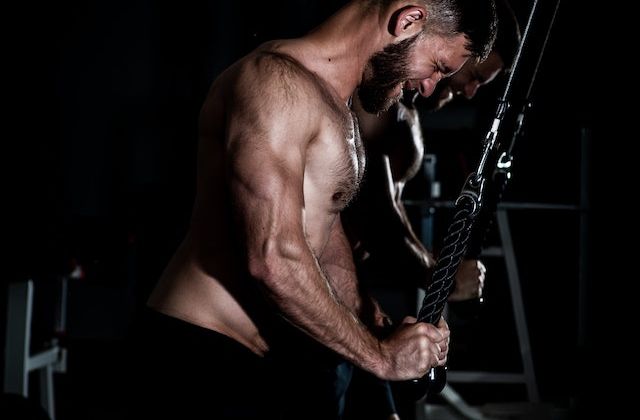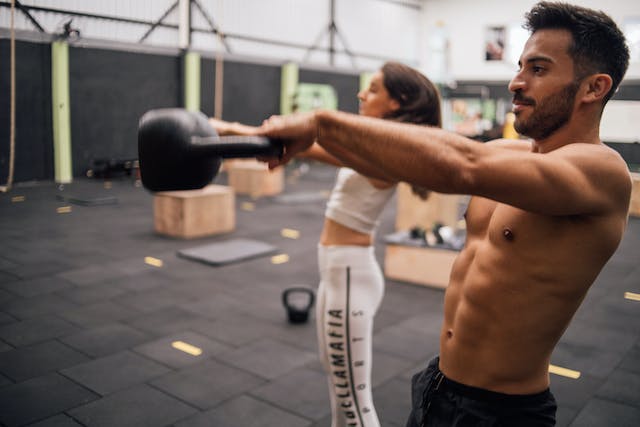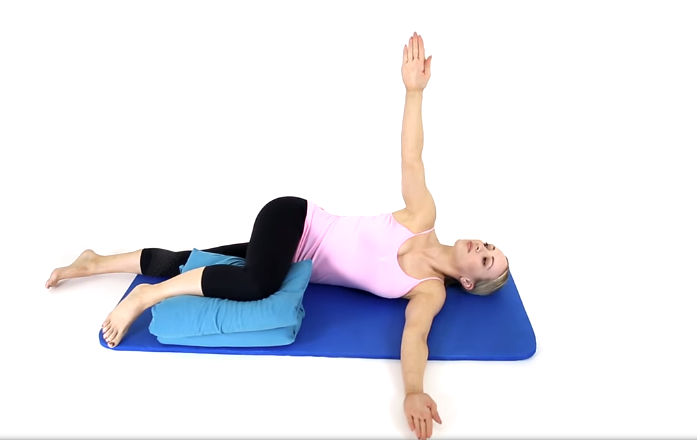The lats muscles are large enough to make you take good care of them, because they take up a lot of space in the back and have an effect on hand movements, rotation, etc., so the Cable Rope Pullover exercise is one of the most powerful exercises that you can rely on to target and sculpt this muscle and Strengthen it well.
In this post, we will learn the correct way to do this exercise, we will also learn about the mistakes that many beginners make and the reason for their lack of results. We will also learn about some alternatives that will help you target the lats muscles without the need for a rope machine.
Let’s continue together!
What is a Cable Rope Pullover?
Pullover exercises is a kind of exercise that has several variables and is done with dumbbells, barbells or cable machines, and the latter is our topic today. The role of the grip on the rope plays an important role in targeting the Lats muscles in particular, and the chest is somewhat ignored. (source)
It is performed on the cable machine where the movement of the pull from the top to the waist plays an important role in isolating the Lats muscles and putting pressure on them and stretching them well.

What muscle does a cable rope pullover work?
In fact, the rope pull exercise targets several muscles in the back, but it focuses mainly on stretching the lats muscles and this has been stated by many trainers because the lats muscles are among the muscles that respond most well to this exercise.
Other muscles are secondarily involved, such as the triceps, posterior deltoid, pectoralis, and rhomboid muscles, which are targeted during movement of the hand.
How are the lats targeted during a rope pull exercise?
The lats muscles are targeted during the pull down, so that your back is straight and pushed forward. This makes the lats muscles expand widely with the movement of your hands from top to bottom, and the movement of the shoulders plays an important role in completing the task so that the lats muscles are well pushed back during the full pull This is what causes the lats to expand when you extend your arms up and contract when you pull your arms to the waist.
How to do a cable rope pullover correctly?
The cable rope pull exercise is one of the best exercises that many bodybuilders rely on, as it works to stretch and contract the lats muscles well, and keeps the muscles under stress throughout the exercise and is good at isolating them and building their strength as well.
How to do it correctly:
- Hold the rope grips.
- Step away from the cable machine.
- Pull the cable a little bit for some tension (i.e. you have to work the muscles before you start).
- Bend your knees slightly (about 10 or 15 degrees).
- Bend your back straight (about 30 or 40 degrees), but keep your shoulders slightly back (feel your mid-back muscles).
- Your hands hold the rope in front of your thighs, also keep your shoulders and the triceps muscles engaged, try not to bend your hands throughout the exercise.
- Pull the cable well in front of your thighs, then let your hands slowly move upward until you feel the lats stretching up and the shoulder muscles as well.
- Then slowly pull back to the front of your thighs, (remember not to bend your hands, keep them in a semi-straight position throughout the exercise).
- Squeeze your lats on each full pull and keep your back firm.
Pro tip:
Focus on pulling the lats muscles with each repetition. You pull in front of the thighs. Focus on pushing the back muscles a little back and pull the lats muscles with them as well. Remember to keep your body steady throughout the exercise and focus with the movement of your hands and keep your muscles under pressure throughout the exercise.
Training program:
| Beginner | Sets: 3 | Reps: 10-12 | Rest: 1 to 2 min |
| Intermediate | Sets: 4 | Reps: 10-12 | Rest: 60 sec |
| Advanced | Sets: 5 | Reps: 10-12² | Rest: 60 sec |
Muscle Worked:
- Latissimus Dorsi
- Pectoralis
- Teres Major
- Deltoids
- Triceps
- Rhomboids
Common mistakes people make during cable rope pullover exercise
If you have been training the lats for a long time with this exercise, and yet you do not notice some drastic changes in the lats muscles, then you will definitely make some mistakes that may prevent you from achieving your goal, this makes many people get frustrated and wonder about the reasons or what they can do to achieve some progress.
These are some of the common mistakes that many make while doing the Cable Rope Pullovers exercise, avoid them now:
Arched back:
This is a very common problem or mistake, because it never helps to stretch the lats muscles, on the contrary, it pushes it all the time forward and does not allow it to stretch back, and thus the exercise becomes useless.
Correct now:
Push your hips back a little, keeping your back straight and leaning forward (30 or 40 degrees), push your shoulders back with each repetition and straighten a little when you reach half the movement while pulling to pull into the rope close to you well, because if you stay a little incline you may have difficulty In pull the cable well near you.
Arm flexion:
Flexing the arms while pulling is also a common mistake among beginners, because bending the arms makes you focus on the muscles of the hand more than the lats and therefore the main muscle does not benefit from the exercise well.
Correct now:
Make a tight grip on the rope. Keep your elbows bent to the side. Bend your elbows slightly about 5 or 10 degrees at most. Keep your arms straight throughout the exercise.
Do not engage the lats muscles:
Many beginners ignore the lats during the lats training itself, so that the muscle stays out of contact and they don’t stress it enough and don’t put it under tension, which reduces the quality of the training.
Correct now:
Try to keep the lats connected as much as possible, this means that you must first prepare your mind that you are going to train the lats, push your shoulders back with each repetition and squeeze the lats well as you go with your hands away to the top and push your shoulders back Press the muscles directly again before towing.
fast movement:
Also, this may not be a serious mistake, but it does not isolate the muscle well, meaning that the muscle does not continue under pressure long enough to exhaust it, and this makes you complete repetitions quickly without targeting the muscle well.
Correct now:
Concentrate on some slow movement, while pulling down well, wait for a second or two and move your hands up slowly again and do the same thing, this keeps the lats muscles tense throughout the exercise.
How to progress?
It is good to make some progress after gaining experience and accustoming the muscles to this type of exercise, because this will make you double the results and get stronger lats.
Go from training the lats using both hands to using only one hand.
- Focus on increasing the intensity of the exercise to make it more powerful.
- Do more compound movements.
- Try to increase the duration of the training to make it a little longer.
- If you train the muscle once a week, try to train it twice.
Does cable rope pull over work for the chest?
The Cable Rope Pullovers exercise does not primarily target the chest muscles, because the large chest muscles have no effect or role in this exercise, but it targets the pectoral muscles by virtue of their connection with the scapula area and this makes them stretch during this exercise, so they are targeted secondary.
What can I use instead of a cable rope pullover?
Well, maybe this will help many people who can’t go to the gym and train on the rope machine, or maybe the rope machine is not available in the gym and this delays you to train the lats muscles.
But there are some alternatives that you can rely on to target the lats muscles and get almost the same exercise as pulling the rope, as it can be done at home and does not need a machine and is also effective.
Best cable rope pullover alternatives at home
Here are the three best and reliable alternatives to train the lats muscles only at home and only using dumbbells, they are provided by good trainers and have given good results with many.
1- Dumbbell Seal Row
Many bodybuilders rely on DB seal rows exercise as a good alternative to train their lats muscles, because it is good at targeting them and provides a good exercise for the back muscles, it can be relied on to build strong and very sculpted lats muscles, as it can be done with barbells or dumbbells.
How to do it correctly:
- Choose dumbbells with a weight that matches your fitness.
- Lay on the bench (on your chest).
- Tighten your body muscles well and stay in a straight shape.
- Hold the dumbbells on each side, try to make the bench slightly raised from the ground. Your arm should be straight when extended to the floor.
- Begin by pulling your fists into your lats, stopping when you push your shoulders back slightly.
- Extend your arms again until they are straight with your shoulders down.
Pro tip:
Each time you pull the dumbbells up, focus on pushing the lats and shoulder muscles back, that is, you must press them throughout the exercise. Also, stretch your hands well, for this you should do it on a high bench because it allows a greater range of movement.
Muscle worked:
- Lats
- Trapezius
- Rear Deltoids
Training program:
| Beginner | Reps: 8-10 | Sets: 3 | Rest: 1 to 2 min |
| Intermediate | Reps: 8-10 | Sets: 4 | Rest: 60 sec |
| Advanced | Reps: 8-10 | Sets: 5 | Rest: 60 sec |
How to:
2- Dumbbell Pendlay Row
Also, this is another exercise for the lats muscles using dumbbells. It targets the back area and focuses on putting pressure on the lats muscles and keeping them under pressure throughout the exercise. It is really a reliable exercise as a good alternative.
How to do it correctly:
- Choose a dumbbell with a weight that you can handle easily.
- Point your feet forward and bend them slightly, about 10 degrees is better.
- Bend your back well until the hips are at a right angle.
- Keep your back straight forward and your spine neutral.
- Hold the dumbbells with your fists, push your chest well and work your shoulders and lats muscles.
- Pull up until your elbows are at a right angle to the sides of your back muscles.
- Throw the dumbbells down until your arms are straight in front of your shoulders.
Pro tip:
Focus on keeping your forearms perpendicular throughout the exercise, that is, do not push your forearms back or to the sides. Focus on pressing the lats muscles and pull your shoulders back a little with each repetition.
Muscle worked:
- Lats
- Rhomboids
- Glutes
- Rear Deltoids
- Hamstrings
Training program:
| Beginner | Reps: 8-10 | Sets: 3 | Rest: 1 to 2 min |
| Intermediate | Reps: 8-10 | Sets: 4 | Rest: 60 sec |
| Advanced | Reps: 8-10 | Sets: 5 | Rest: 60 sec |
How to:
3- Single Arm Dumbbell Row
This exercise is one of the favorite exercises. The dumbbell row with one arm is a great option for training the lats muscles and keeping them tense throughout the exercise. It is also effective in building muscles and building their endurance. It targets every side on its own and that’s what makes you focus on every muscle well and get a good workout.
How to do it correctly:
- We’ll be working with one dumbbell, so choose a weight that matches your fitness level.
- Stand about half a step near the bench.
- Bend your feet about 10 or 15 degrees, keeping them facing forward.
- Place the hand that is not holding the dumbbell on the bench straight in front of your shoulder.
- Bend your back to the distance of your arm to the bench very straight.
- Keep the height of the shoulders slightly above the height of the hips, keep your head neutral.
- Pull the dumbbells from the depth to the top towards the lats muscles directly, pull your shoulders back as well as your elbows.
- Slowly let your arm fall until it is straight in front of the shoulder.
Pro tip:
Many beginners and even professionals when they do this exercise put their knee on the bench and this makes the spine unstable so avoid doing this, all you should focus on is the elbow movement, keep your forearms in a vertical shape, and drive your elbow behind your back and focus To squeeze the lats muscles well, that is, push them back as soon as you pull the dumbbells up.
Muscle worked:
- Lats
- Shoulders
- Biceps
- Hips
Training program:
| Beginner | Reps: 8-10 | Sets: 3 | Rest: 1 to 2 min |
| Intermediate | Reps: 8-10 | Sets: 4 | Rest: 60 sec |
| Advanced | Reps: 8-10 | Sets: 5 | Rest: 60 sec |
Train your lats safely
If you are a complete beginner, I advise you to train with a specialized trainer because he will help you understand the movements and how to do them correctly, and the trainer can protect you from some injuries that can easily happen to you while training on your own.
Focus on your lats every week, allow them to recover at least 48 hours before training them again, also stick to the exercises and try to make some progress.
Useful links
These links may be useful to you if you are a fan of building fitness and strength or gaining muscle at home, these links contain the most powerful CrossFit exercises that you can rely on mainly.
If you are a fan of bodyweight workouts, you can rely on these workouts at home, believe me, you may not need anyone to build strong fitness only at home.
More than 50 Bodyweight wods for beginners (no equipment needed)
Best Jump rope wods to burn a lot of calories
Bodyweight exercises for bigger triceps at home
If you have some equipment such as dumbbells, or a bar and some weights and you are a fan of building muscle, you may want to try the best CrossFit workouts for strength and build muscle endurance.
10 Best cable crossover alternatives at home
12 Best Triceps and Biceps exercises for big arms
Effective exercises for leg strength and hypertrophy
Strength your back with the best reverse pec deck alternatives
If you are used to going to the gym, you can train the back area with the best cable workouts for the back.



